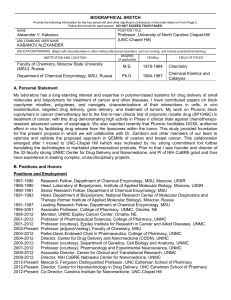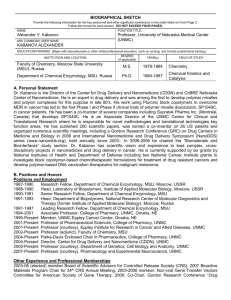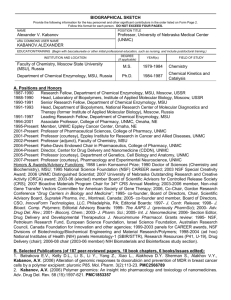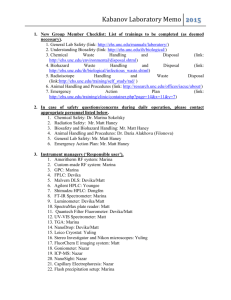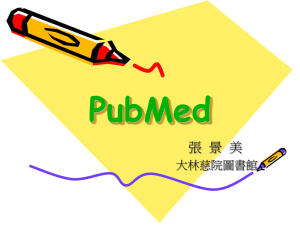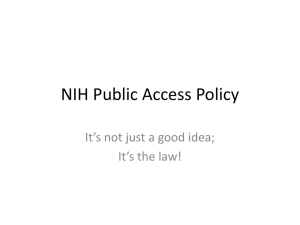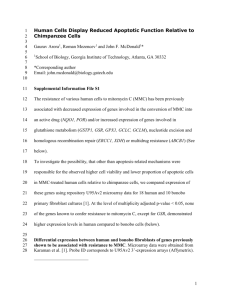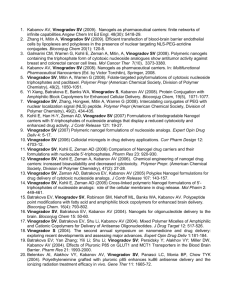Biosketch - Kabanov Lab
advertisement
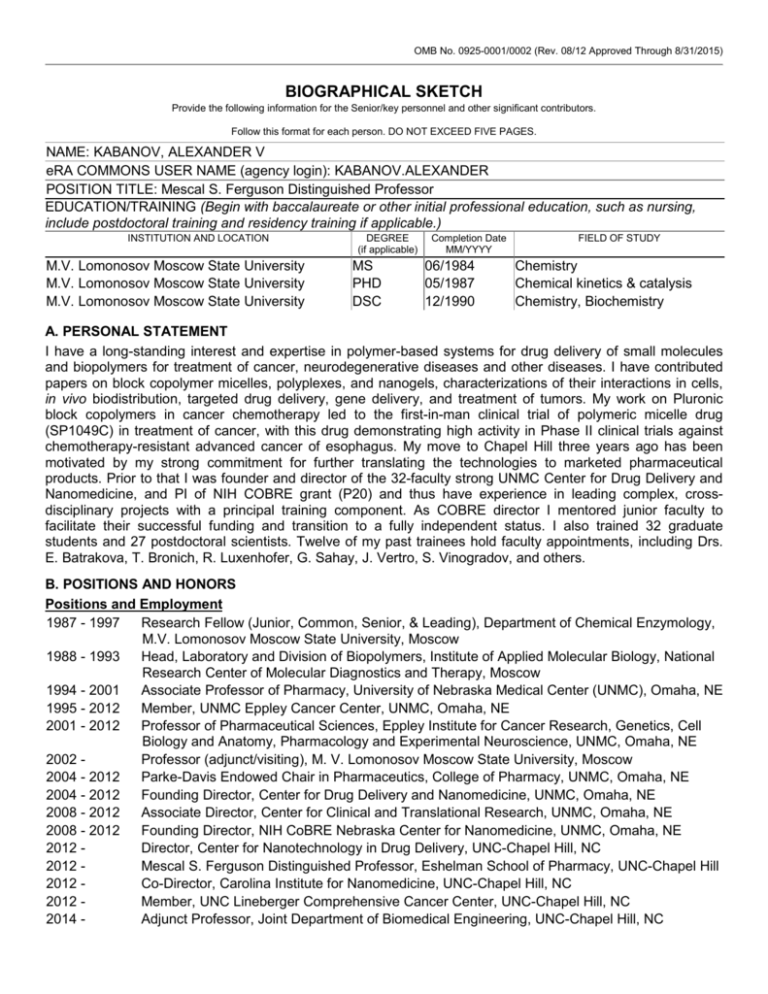
OMB No. 0925-0001/0002 (Rev. 08/12 Approved Through 8/31/2015) BIOGRAPHICAL SKETCH Provide the following information for the Senior/key personnel and other significant contributors. Follow this format for each person. DO NOT EXCEED FIVE PAGES. NAME: KABANOV, ALEXANDER V eRA COMMONS USER NAME (agency login): KABANOV.ALEXANDER POSITION TITLE: Mescal S. Ferguson Distinguished Professor EDUCATION/TRAINING (Begin with baccalaureate or other initial professional education, such as nursing, include postdoctoral training and residency training if applicable.) INSTITUTION AND LOCATION M.V. Lomonosov Moscow State University M.V. Lomonosov Moscow State University M.V. Lomonosov Moscow State University DEGREE (if applicable) MS PHD DSC Completion Date MM/YYYY 06/1984 05/1987 12/1990 FIELD OF STUDY Chemistry Chemical kinetics & catalysis Chemistry, Biochemistry A. PERSONAL STATEMENT I have a long-standing interest and expertise in polymer-based systems for drug delivery of small molecules and biopolymers for treatment of cancer, neurodegenerative diseases and other diseases. I have contributed papers on block copolymer micelles, polyplexes, and nanogels, characterizations of their interactions in cells, in vivo biodistribution, targeted drug delivery, gene delivery, and treatment of tumors. My work on Pluronic block copolymers in cancer chemotherapy led to the first-in-man clinical trial of polymeric micelle drug (SP1049C) in treatment of cancer, with this drug demonstrating high activity in Phase II clinical trials against chemotherapy-resistant advanced cancer of esophagus. My move to Chapel Hill three years ago has been motivated by my strong commitment for further translating the technologies to marketed pharmaceutical products. Prior to that I was founder and director of the 32-faculty strong UNMC Center for Drug Delivery and Nanomedicine, and PI of NIH COBRE grant (P20) and thus have experience in leading complex, crossdisciplinary projects with a principal training component. As COBRE director I mentored junior faculty to facilitate their successful funding and transition to a fully independent status. I also trained 32 graduate students and 27 postdoctoral scientists. Twelve of my past trainees hold faculty appointments, including Drs. E. Batrakova, T. Bronich, R. Luxenhofer, G. Sahay, J. Vertro, S. Vinogradov, and others. B. POSITIONS AND HONORS Positions and Employment 1987 - 1997 Research Fellow (Junior, Common, Senior, & Leading), Department of Chemical Enzymology, M.V. Lomonosov Moscow State University, Moscow 1988 - 1993 Head, Laboratory and Division of Biopolymers, Institute of Applied Molecular Biology, National Research Center of Molecular Diagnostics and Therapy, Moscow 1994 - 2001 Associate Professor of Pharmacy, University of Nebraska Medical Center (UNMC), Omaha, NE 1995 - 2012 Member, UNMC Eppley Cancer Center, UNMC, Omaha, NE 2001 - 2012 Professor of Pharmaceutical Sciences, Eppley Institute for Cancer Research, Genetics, Cell Biology and Anatomy, Pharmacology and Experimental Neuroscience, UNMC, Omaha, NE 2002 Professor (adjunct/visiting), M. V. Lomonosov Moscow State University, Moscow 2004 - 2012 Parke-Davis Endowed Chair in Pharmaceutics, College of Pharmacy, UNMC, Omaha, NE 2004 - 2012 Founding Director, Center for Drug Delivery and Nanomedicine, UNMC, Omaha, NE 2008 - 2012 Associate Director, Center for Clinical and Translational Research, UNMC, Omaha, NE 2008 - 2012 Founding Director, NIH CoBRE Nebraska Center for Nanomedicine, UNMC, Omaha, NE 2012 Director, Center for Nanotechnology in Drug Delivery, UNC-Chapel Hill, NC 2012 Mescal S. Ferguson Distinguished Professor, Eshelman School of Pharmacy, UNC-Chapel Hill 2012 Co-Director, Carolina Institute for Nanomedicine, UNC-Chapel Hill, NC 2012 Member, UNC Lineberger Comprehensive Cancer Center, UNC-Chapel Hill, NC 2014 Adjunct Professor, Joint Department of Biomedical Engineering, UNC-Chapel Hill, NC Other Experience and Professional Memberships 1994 – Member, American Chemical Society 1995 – Co-founder/founder, Supratek Pharma, Inc., Montreal, Canada (1995); InnovaForm Technologies, LLC, Philadelphia, PA (2005); Neuronano Pharma, Inc., Chapel Hil, NC (2012) 2003 - 2006 Member (elected), Board of Scientific Advisors, Controlled Release Society 2003 - 2008 Member / Chair (2006-08), NIH BMBI study section 2013 Member (elected), Academia Europaea (The Academy of Europe) 2014 Fellow (elected), American Institute for Medical and Biological Engineering Honors 1988 1991 1995 2007 2009 2010 2014 Lenin Komsomol Prize, USSR Medal “For Valiant Labor”, USSR CAREER award, National Science Foundation Outstanding Research & Creative Activity (ORCA) award, University of Nebraska Scientist Laureate, UNMC Russian "Megagrant", Government of Russia Highly Cited (Pharmacology & Toxicology), Thompson Reuters C. CONTRIBUTION TO SCIENCE 1. Polymeric micelles for drug delivery. In 1989 we pioneered use of polymeric micelles for targeted drug delivery. We discovered sensitization of multidrug resistant cancer and cancer stem cells by Pluronic block copolymers and established mechanisms responsible for these effects. This research led to first-in-man polymeric micelle drug candidate to treat cancer (SP1049C) that has shown high efficacy against advanced esophageal cancer in phase II clinical trial. Our recent work discovered polymeric micelles based on poly(2-oxazolines) with unprecedented high capacity for poorly soluble uncharged drugs (e.g. taxanes) and drug combinations allowing increasing therapeutic index compared to current drug formulations. a. Kabanov AV, Chekhonin VP, Alakhov VYu, Batrakova EV, Lebedev AS, Melik-Nubarov NS, Arzhakov SA, Levashov AV, Morozov GV, Severin ES. The neuroleptic activity of haloperidol increases after its solubilization in surfactant micelles. Micelles as microcontainers for drug targeting. FEBS Lett. 1989 Dec 4;258(2):343-5. PubMed PMID: 2599097. b. Alakhov VYu, Moskaleva EYu, Batrakova EV, Kabanov AV. Hypersensitization of multidrug resistant human ovarian carcinoma cells by pluronic P85 block copolymer. Bioconjug Chem. 1996 MarApr;7(2):209-16. PubMed PMID: 8983343. c. Luxenhofer R, Schulz A, Roques C, Li S, Bronich TK, Batrakova EV, Jordan R, Kabanov AV. Doubly amphiphilic poly(2-oxazoline)s as high-capacity delivery systems for hydrophobic drugs. Biomaterials. 2010 Jun;31(18):4972-9. PubMed PMID: 20346493; PubMed Central PMCID: PMC2884201. d. Alakhova DY, Kabanov AV. Pluronics and MDR reversal: an update. Mol Pharm. 2014 Aug 4;11(8):2566-78. PubMed PMID: 24950236; PubMed Central PMCID: PMC4122590. 2. Pluronic copolymers for delivery of drugs across cell barriers. In mid 90-ies we discovered that Pluronic block copolymers inhibit drug efflux transport systems (e.g. P-gp) in intestinal epithelium and brain endothelium and thereby enhance permeability of the substrates of these systems across respective cellular barriers. We established the mechanism of this effect and the structure-functional requirements for the copolymers, and demonstrated possibility of increasing oral and brain bioavailability of corresponding drugs by co-formulating these drugs with Pluronics. These findings have significantly advanced the use of block copolymers in pharmaceutical formulations by academic scientists and industry. a. Batrakova EV, Han HY, Miller DW, Kabanov AV. Effects of pluronic P85 unimers and micelles on drug permeability in polarized BBMEC and Caco-2 cells. Pharm Res. 1998 Oct;15(10):1525-32. PubMed PMID: 9794493. b. Batrakova EV, Li S, Miller DW, Kabanov AV. Pluronic P85 increases permeability of a broad spectrum of drugs in polarized BBMEC and Caco-2 cell monolayers. Pharm Res. 1999 Sep;16(9):1366-72. PubMed PMID: 10496651. c. Batrakova EV, Miller DW, Li S, Alakhov VY, Kabanov AV, Elmquist WF. Pluronic P85 enhances the delivery of digoxin to the brain: in vitro and in vivo studies. J Pharmacol Exp Ther. 2001 Feb;296(2):551-7. PubMed PMID: 11160643. d. Batrakova EV, Li S, Vinogradov SV, Alakhov VY, Miller DW, Kabanov AV. Mechanism of pluronic effect on P-glycoprotein efflux system in blood-brain barrier: contributions of energy depletion and membrane fluidization. J Pharmacol Exp Ther. 2001 Nov;299(2):483-93. PubMed PMID: 11602658. 3. Polymer-based gene delivery. In late 80-ies we were the first to describe gene transfer to bacterial cells using polyion complexes of DNA and polycations. Our work on mammalian cell transfection using DNApoly(4-vinylpyridinium) in 1993 (simultaneous with work by F. Szoka on cationic dendrimers) introduced a prototype of polyplexes currently used in cell transfection in hundreds of labs across the globe. In 1995 we invented uncharged polyplexes produced by coupling the cationic block copolymers with nucleic acids that have been widely researched for the delivery of nucleic acids by many labs and companies. Recently we discovered that polyplex-transfected macrophages can deliver genes to sites of inflammation in the brain and other tissues involving horizontal gene transfer from macrophages to new host cells in these sites. We have shown that these processes can be greatly enhanced by nonionic Pluronic block copolymers, which can also enhance gene expression and improve gene delivery to skeletal muscle with naked DNA. a. Kabanov AV, Kabanov VA. DNA complexes with polycations for the delivery of genetic material into cells. Bioconjug Chem. 1995 Jan-Feb;6(1):7-20. PubMed PMID: 7711106. b. Kabanov AV, Vinogradov SV, Suzdaltseva YG, Alakhov VYu. Water-soluble block polycations as carriers for oligonucleotide delivery. Bioconjug Chem. 1995 Nov-Dec;6(6):639-43. PubMed PMID: 8608176. c. Yang Z, Zhu J, Sriadibhatla S, Gebhart C, Alakhov V, Kabanov A. Promoter- and strain-selective enhancement of gene expression in a mouse skeletal muscle by a polymer excipient Pluronic P85. J Control Release. 2005 Nov 28;108(2-3):496-512. PubMed PMID: 16154658. d. Haney MJ, Zhao Y, Harrison EB, Mahajan V, Ahmed S, He Z, Suresh P, Hingtgen SD, Klyachko NL, Mosley RL, Gendelman HE, Kabanov AV, Batrakova EV. Specific transfection of inflamed brain by macrophages: a new therapeutic strategy for neurodegenerative diseases. PLoS One. 2013;8(4):e61852. PubMed PMID: 23620794; PubMed Central PMCID: PMC3631190. 4. Polyion complex micelles & nanogels for drug delivery. In mid 90-ies we (simultaneously with K. Kataoka) demonstrated possibility of formation of polyion complex micelles through ionic complexation of block polyelectrolytes and proposed using these micelles for delivery of charged drugs, nucleic acids and proteins. We also we also were first to propose cross-linked polyelectrolyte nanogels and polymeric micelles with cross-linked polyion cores for drug delivery. Due to their softness, stability, and lack of defined “surface” these gel-like materials have shown promise for targeted drug delivery to tumors and other disease sites. Our recent work has shown improved delivery of polypeptides incorporated in polyion complexes to the brain to treat brain injury, neurodegenerative and neurodevelopmental disorders. a. Kabanov AV, Bronich TK, Kabanov VA, Yu K, Eisenberg A. Spontaneous formation of vesicles from complexes of block ionomers and surfactants. J. Am. Chem. Soc.. 1998; 120:9941-9942. b. Vinogradov SV, Bronich TK, Kabanov AV. Nanosized cationic hydrogels for drug delivery: preparation, properties and interactions with cells. Adv Drug Deliv Rev. 2002 Jan 17;54(1):135-47. PubMed PMID: 11755709. c. Nukolova NV, Oberoi HS, Cohen SM, Kabanov AV, Bronich TK. Folate-decorated nanogels for targeted therapy of ovarian cancer. Biomaterials. 2011 Aug;32(23):5417-26. PubMed PMID: 21536326; PubMed Central PMCID: PMC3255291. d. Manickam DS, Brynskikh AM, Kopanic JL, Sorgen PL, Klyachko NL, Batrakova EV, Bronich TK, Kabanov AV. Well-defined cross-linked antioxidant nanozymes for treatment of ischemic brain injury. J Control Release. 2012 Sep 28;162(3):636-45. PubMed PMID: 22902590; PubMed Central PMCID: PMC3597468. 5. Modified polypeptides for CNS delivery. In late 80-ies (jointly with V. Chekhonin) we invented covalent modifications of polypeptides with fatty acids to improve the delivery of these polypeptides to the brain. This early work precipitated continuous interest and publications by others on fatty acylated peptides that in 2009 resulted in approval and marketing of Liraglutide, a once-daily injectable fatty acylated derivative of the glucagon-like peptide-1 (GLP-1), for the treatment of type 2 diabetes or obesity. In 2005 we invented covalent modification of polypeptides with amphiphilic block copolymers to increase brain bioavailability of polypeptides. We have shown the potential of this technology to improve overweight and obesity treatment. a. Chekhonin VP, Kabanov AV, Zhirkov YA, Morozov GV. Fatty acid acylated Fab-fragments of antibodies to neurospecific proteins as carriers for neuroleptic targeted delivery in brain. FEBS Lett. 1991 Aug 5;287(1-2):149-52. PubMed PMID: 1715283. b. Tong J, Yi X, Luxenhofer R, Banks WA, Jordan R, Zimmerman MC, Kabanov AV. Conjugates of superoxide dismutase 1 with amphiphilic poly(2-oxazoline) block copolymers for enhanced brain delivery: synthesis, characterization and evaluation in vitro and in vivo. Mol Pharm. 2013 Jan 7;10(1):360-77. PubMed PMID: 23163230; PubMed Central PMCID: PMC3570234. c. Yi X, Manickam DS, Brynskikh A, Kabanov AV. Agile delivery of protein therapeutics to CNS. J Control Release. 2014 Sep 28;190:637-63. PubMed PMID: 24956489; PubMed Central PMCID: PMC4142106. d. Yi X, Yuan D, Farr SA, Banks WA, Poon CD, Kabanov AV. Pluronic modified leptin with increased systemic circulation, brain uptake and efficacy for treatment of obesity. J Control Release. 2014 Oct 10;191:34-46. PubMed PMID: 24881856; PubMed Central PMCID: PMC4197010. D. RESEARCH SUPPORT Ongoing Research Support 2015/09/15-2017/07/31 1R21NS088152-01A1 National Institute of Neurological Disorders and Stroke KABANOV, ALEXANDER V (PI) Nanoformulation of the BDNF for Treatment of Stroke We propose brain-derived neurotrophic factor (BDNF) into a simple nano-format with safe and biocompatible polymers. This will improve the brain uptake of BDNF and increase efficacy of BDNF treatment after the stroke. The proposal will identify the lead drug candidate for further preclinical development. Role: PI 2015/09/15-2020/07/31 1U54CA198999-01 National Cancer Institute (NCI) HUANG, LEAF (PI), KABANOV, ALEXANDER V (PI, Project 4) Carolina Center for Cancer Nanotechnology excellence: Nano Approaches to Modulate Host Cell Response for Cancer Therapy. Project 4: High Capacity Polymeric Micelle Therapeutics for Lung Cancer The central goal of Project 4 of the CCNE is to improve systemic therapies for non-small cell lung cancer (NSCLC) using combinations of potent anticancer agents, chemosensitizers, and agents that target the tumor microenvironment. Role: PI Project 4 2015/08/14-2020/07/31 1U01CA198910-01 National Cancer Institute (NCI) KABANOV, ALEXANDER V (PI), BRONICH, TATIANA (CPI), LIU, RIHE (CPI) Targeted Core Shell Nanogels for Triple Negative Breast Cancer The research focuses on an innovative targeting strategy to treat triple negative breast cancer (TNBC); we use biodegradable nanogels that carry chemotherapeutic agents and are decorated with polypeptide antagonists to EFGR and HER3 receptors displayed in the TNBC that act in concert with the delivered drugs and inhibit downstream signaling pathways to produce most potent therapeutic effect on the TNBC. Role: PI 2015/07/01-2020/06/30 1T32CA196589-01 National Cancer Institute (NCI) KABANOV, ALEXANDER V (PI) Carolina Cancer Nanotechnology Training Program (C-CNTP) This program is to train postdoctoral research fellows who will successfully pursue careers in academia, industry, and government agencies, and become significant contributors to addressing emerging challenges in public health and medical research using nanotechnology to diagnose and treat cancer. Role: PI 2015/01/01-2019/12/31 R01CA184088-02 National Cancer Institute (NCI) KABANOV, ALEXANDER V (PI), ZAMBONI, WILLIAM (CPI) Liposomal Doxorubicin and Pluronic Combination for Cancer Therapy We propose a novel simple strategy to increase the efficacy of PLD treatment by promoting the release of the active ingredient (doxorubicin) from the liposomal particles directly within the tumor matrix, while concurrently sensitizing this tumor to the drug using Pluronic block copolymer. Role: PI 2013/07/01-2017/06/31 HDTRA1-09-14-FRCWMD-BAA Department of Defense DESIMONE, JOSEPH M (PI), KABANOV, ALEXANDER V (CPI) PRINT Butyrylcholinesterase (BuChE) Delivery This proposal will address the ability of the PRINT particle platform to deliver the large molecule butyrylcholinesterase to scavenge organophosphate (OP)-derived nerve agents. Role: CPI 2015/01/01-2016/12/01 HeART Award #3112 Rettsyndrome.org KABANOV, ALEXANDER V (PI) Nanoformulated Brain Derived Neurotrophic Factor (BDNF) for the Treatment of Rett Syndrome We use “nanocytokine” delivery technology to increase the amounts of the therapeutic protein, BDNF that reaches the brain after intravenous administration. Role: PI 2005/04/01-2016/03/31* R01 NS051334-09 National Institute of Neurological Disorders and Stroke KABANOV, ALEXANDER V (PI), BANKS, WILLIAM (CPI) * no cost extension Polypeptide Modification for Enhanced Brain Delivery The goal is to produce polypeptides that can cross the blood-brain barrier (BBB) and be developed as central nervous system therapeutics. Analogs completing this development will be a) active in brain, b) have favorable pharmacokinetics, c) be able to cross the BBB in obese mice, and d) reverse obesity after iv injection. Role: PI 2014/12/01-2015/11/30 4DR11404 NC TraCS Institute KABANOV, ALEXANDER V (PI), TROPSHA, ALEX (CPI) delAQUA - Computer-assisted Drug Solubilization Platform We develop a versatile, cheminformatics-aided high throughput and high capacity nano-formulation platform employing poly(2-oxozaline)-based polymeric micelles for rapid screening, selection and successful solubilization of water insoluble or poorly water-soluble APIs. Role: PI 2010/09/02-2016/07/31* U01 CA151806-05 National Cancer Institute (NCI) KABANOV, ALEXANDER V (PI) * no cost extension High Capacity Nanocarriers for Cancer Chemotherapeutics We will optimize poly(2-oxazoline)s structures for paclitaxel; determine pharmacokinetics and maximum tolerated doses; validate anti-tumor activity in mouse models of breast cancer. This project joins together pharmaceutical scientists and cancer researchers in the NCI Alliance for Cancer Nanotechnology. Role: PI Completed Research Support 2013/09/01-2015/08/31 DMR-1121107 National Science Foundation LOPEZ, GABRIEL (PI) Triangle Center for Excellence for Materials Research and Innovation: Programmable Assembly of Soft Matter Ferrogels for remote diagnostics and therapy - seed project (fellowship to a graduate student) to develop new research agenda on magnetic field responsive nano-ferrogels. Role: Faculty 2010/07/15-2015/04/30 P01 DA028555-03 National Institute on Drug Abuse (NIDA) GENDELMAN, HOWARD (PI) KABANOV, ALEXANDER V (PI Project 1) Nanoformulation Manufacture and Characterization This is an integrative translational multi-investigator program grant seeking to develop nanoformulated antiretroviral drug therapy from the bench to the patient. Project 1 focus on NanoART manufacturing. Role: PI 2010/11/10-2014/12/31 11.G34.31.0004 Russian Ministry of Science and Education KABANOV, ALEXANDER V (PI) Chemical Design of Bionanomaterials This is an infrastructure grant from Russian Ministry of Sci. and Education to establish a new laboratory at MSU to design and characterize novel bionanomaterials. Dr. Kabanov serves as visiting laboratory director at MSU. Research focuses on antioxidant, antibacterial and pesticide-scavenging enzyme therapeutics. Role: PI 2011/08/29-2014/08/28 W81XWH-11-1-0700 Department of Defense MALLAPRAGADA, SURYA K (PI), KABANOV, ALEXANDER V (CPI) INNS: Integrated neuroprotective and neuroregenerative strategies This proposal develops cell-nanomedicine based therapeutics. Role: CPI 2010/09/01-2013/08/31 W81XWH-10-1-0806 Department of Defense MALLAPRAGADA, SURYA K (PI), KABANOV, ALEXANDER V (CPI) Platforms Against Respiratory Pathogens (TANARP) We develop targeted vaccines against respiratory infections using pseudotyping and nanotechnology platforms based on degradable adjuvant polymers that enhance antigen presentation and stimulate immunity. Role: CPI 2009/07/01-2013/06/30 W81XWH-09-1-0386 Department of Defense KABANOV, ALEXANDER V (PI), MALLAPRAGADA, SURYA K (CPI) Synthetic Nanovaccines Against Respiratory Pathogens (SYNARP) We develop fully synthetic vaccines against respiratory infections using nanotechnology platforms based degradable adjuvant polymer systems that enhance antigen presentation and stimulate immunity. Role: PI 2000/12/01-2013/01/31 R01 CA089225-09 National Cancer Institute (NCI) KABANOV, ALEXANDER V (PI) Interactions of Pluronic block copolymers in drug resistant cancer The aims characterize the effects of Pluronic on ATP levels in resistant and sensitive cells, identify drug/Pluronic formulations effective against resistant cancers; determine whether the effects of Pluronic on the energy state of the cell inhibit specific drug resistance mechanisms in vitro and in vivo. Role: PI Additional information: 263 papers, over 21,500 citations; h-factor 80; 30 US patents awarded, over 100 patents and pending applications worldwide.
